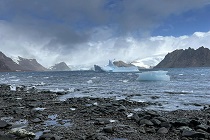 On 13 January 2025, a team of geologists from the Polish Geological Institute – National Research Institute set off for Antarctica. This is the fifth expedition under the substantive leadership of Prof. Jerzy Nawrocki, with the objective being King George Island, located in West Antarctica.
On 13 January 2025, a team of geologists from the Polish Geological Institute – National Research Institute set off for Antarctica. This is the fifth expedition under the substantive leadership of Prof. Jerzy Nawrocki, with the objective being King George Island, located in West Antarctica.
In addition to carrying out research work at the Henryk Arctowski Polish Antarctic Station, the PGI-NRI team, in cooperation with the Argentine Geological Survey, plans to explore the areas around the Carlini Station. Most likely, the PGI-NRI expedition will also visit Seymour Island, located near the northern tip of the Antarctic Peninsula.
The main objective of the expedition is to carry out a task of the State Geological Survey focused on the integration of research methods in geological mapping of ice-covered areas using geophysical techniques. The work will involve, among other things, transferring geological data from sections of the coast that are devoid of ice cover to areas covered by it, about which we know only to a limited extent.
Of particular value will be the data on the thickness of the ice cover in the area under study, made available by the Institute of Biochemistry and Biophysics of the Polish Academy of Sciences.
The expedition leader, Prof. Jerzy Nawrocki is taking to Antarctica a team of three geologists: Weronika Czarnecka, M.Sc., responsible for preparing samples for geochemical and petrological studies, Marcin Olkowicz, M.Sc., who will operate a drone with a magnetometer, and Jakub Bazarnik, Ph.D., an experienced geologist and polar explorer. Thanks to this team composition, the work initiated by Prof. Jerzy Nawrocki can be continued in the future by the younger generation of scientists.

Part of the expedition group just before leaving for the airport: Prof. Jerzy Nawrocki, Weronika Czarnecka, M.Sc. and Marcin Olkowicz, M.Sc.
The analyses initiated during the expedition will then be carried out, upon return, in the Institute's laboratories. Their results will allow assessment of the geological structure of the study area, including determination of the rocks' age. The collected data will allow interpretation of magnetic curves and analysis of anomalies. The research will result in geological-geophysical models and a set of geochemical and petrological data on the studied rocks. If suitable minerals will be found, it will also be possible to determine their precise age.

Loading the last box with the necessary research equipment into the car
Cooperation with the Argentine Geological Survey will produce valuable guidelines for geological mapping of ice-covered areas.
The completion of the expedition is planned for February/March this year.
Text and photos: Artur Baranowski















 PGI-NRI offer
PGI-NRI offer Mineral resources of Poland
Mineral resources of Poland  Oil and Gas in Poland
Oil and Gas in Poland 




 Subscribe to RSS Feed
Subscribe to RSS Feed